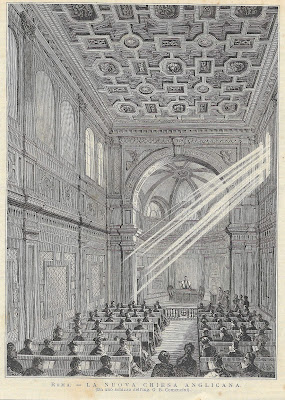The Anglican Community in Rome, the community splits in half.
The second edition of the history of the Anglican community in Rome will explore perhaps a lesser known fact - very few people know that for almost 70 years Rome had another Anglican church, here is its story. During the 1870s, some disaffected worshippers at the Granary Chapel, who found the ministry of the then assistant priest slightly too ritualistic for their taste, decided to set up a rival congregation for Church of England services. Aided by one Bishop Alford of the Diocese of Victoria, Hong Kong - soon after 1870 with the new freedom for non-Catholics to build houses of worship - they engaged architect Antonio Cipolla to design a new church.
The Piazza San Silvestro in the 1880s with Holy Trinity Church to the right.
A church dedicated to the Holy Trinity with a modest classical façade that looked across the Piazza San Silvestro to what is now the Post Office, was completed by about 1873 and inaugurated on 26 October 1874, thanks to the handsome response to the dissidents’ appeal in the London Times. The church had come to serve a growing English-speaking congregation, the article in the London Times commends its style of worship conducted with dignity and reverence and it highlights the clergy’s efforts to maintaining an Anglican ethos in a most Catholic environment – the article also highlights the first Protestant church in Rome as a symbol of religious liberty – a novelty in the former capital of the Papal States. This was the first Anglican church to be built within the walls of Rome. While the Granary Chapel (the English Church) and All Saints' (from the 1880s onwards) was the high church in Rome, Holy Trinity became the low church, Evangelical site. That difference being not so subtle when looking at the interior of both the first and second church, as the altar is not as central as at All Saints' and with the reredos displaying the Lord's Prayer and Commandments, a feature of 18th and 19th century Evangelical churches.
The façade of Holy Trinity Church in the Piazza San Silvestro in a picture from the late 19th century.
Interestingly enough, this was the church where C.S. Lewis' maternal grand-father and Church of Ireland priest, Thomas Hamilton, served as a chaplain between 1870 and 1874. Flora Hamilton, C.S. Lewis' mother was a child of the parish. Anglican Rome can claim a connection with one of the greatest Anglican writers of all time.
Holy Trinity Church in an Italian print from 1875.
Holy Trinity was a part of the life of the English colony in Rome as much as All Saints', because of its Evangelical churchmanship, and as it was customary across Anglicanism at the time, the great events of the time were usually the main theme of a Sunday service. There is one notable sermon we still have from the sinking of the RMS Titanic. Many in the upper class at London, New York, Rome and Paris would have known someone aboard the ship, there would have therefore been a special connection between the congregation and this maritime tragedy which echoed across the globe.
A copy of the sermon preached after the sinking of the RMS Titanic.
Only about forty years later, about the time of the Great War, the new church had to be demolished to make way for an enlargement of the square. A new site was found in the then via Dogali, now via Romagna, in the Ludovisi district of Rome, which at the time was fast developing with housing for the mid-upper classes of the fairly new capital of the Italian state; the new site was near the British Embassy and the housing of many in the English colony of Rome.
The original design for the church as in the postcard that was given out at the laying down of the cornerstone.
The foundation stone of the new Holy Trinity was laid on 28th April 1913 by Ambassador Sir Rennel Rodd, the silver trowel used for this purpose is still in possession of All Saints’. Clergy from All Saints' and St. Paul's were present, including the combined choirs, as well as the Bishop of Gibraltar who delivered the address. The church, which could sit some 300 people, was 30 meters (100 ft) long and 15 meters (50 ft) both in width and height, there was also going to be a 33 meters (110 ft) high bell tower. The building was decorated in red brick and travertine.
The trowel used to lay the foundation stone of the second Holy Trinity Church in 1913.
The church was designed in the Italian Romanesque-Revival style by Edmund Fisher, a British architect. Work was carried out by a certain Signor Monti with the builders being Donaldi and Rinaldi of Rome. The style of the church, unlike that of All Saints', was meant to be blending with the local architecture.
The service registers witness to a fairly thriving life in the 1920s, with church services and various social events hosted in the fairly cozy crypt, as well as acts of cooperation with All Saints’ - confirmations for example, even Lenten retreats - encouraged by the then Bishop of Gibraltar, only a few years after his predecessors had disapproved of the split. However, with numbers going down with the approach of the war, the last services were held on 18th April 1937. In about 1945, an Italian book reported it “lost among greenery, vandalized and closed for worship many years ago”. In 1948, the site was sold for development, the church demolished, and offices built were once English Anglicans had their other home in Rome.
The interior of the second Holy Trinity Church as photographed shortly after its construction.

.jpg)




.jpeg)


